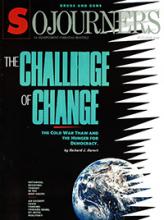BEFORE THE U.S. NAVY CAME to town, St. Mary's, Georgia, was a quiet little coastal community. Like many towns along the southeastern coast, the major industries were fishing and the paper mill on the edge of town. It served as the home port only for some shrimping boats and the ferry to Cumberland Island, a beautiful oasis for wildlife and campers located across from Kings Bay.
But soon after Spain decided in 1975 that it would no longer allow U.S. nuclear submarines to be homeported on its coast, Kings Bay emerged as a centerpiece in the U.S. strategic "triad" of nuclear weapons. In 1979, Kings Bay--the site of cotton and sugar cane plantations in the early 19th century--was selected as the East Coast home for a fleet of Trident nuclear submarines. Ten Tridents, which have been called "the ultimate first-strike weapon" by former Trident designer Robert Aldridge because of the deadly range and accuracy of the Trident D-5 missiles, were expected to be deployed at Kings Bay.
It was anything but quiet in the decade after that. The influx of base workers and their families into the county caused a dramatic rise in population--from about 13,000 people in 1980 to more than 22,000 in 1988--and the population was expected to climb to 40,000 by 1999.
The result was an economic boon for the county, with housing and services springing up to meet the growing needs of the community. The federal government has given $38 million in "community impact funds" to the area since 1984 to help pay for additional schools and municipal services, but the funds may be drying up. The federal Office on Economic Adjustment has suggested $3.7 million for fiscal year 1990, a figure local leaders say is too low to pay for needed construction of an additional high school in the area.
Read the Full Article

